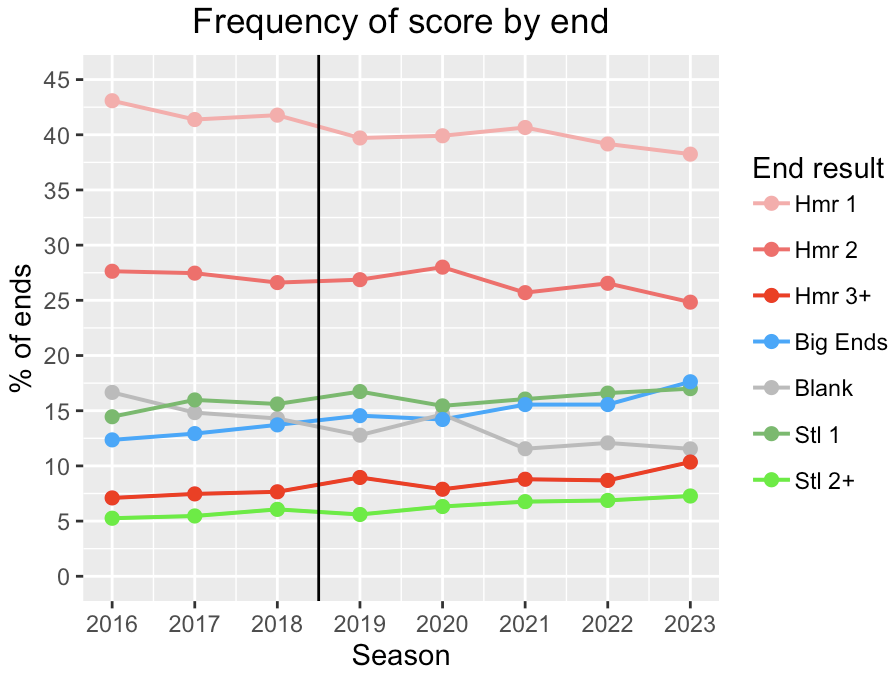In the previous post, we looked at the effect of the 5-rock rule and saw that non-hammer has been more aggressive to start ends. We also want to know how this has affected scoring, so let’s take a look.
All data is from games in the Brier/Scotties, Grand Slams, European Championships, and Worlds with a few other random events of similar quality that have existed over time (Pointsbet Invitational, Canada Cup, Manitoba championship finals, and World Cup) and includes all ends.
The follow graph summarizes all of this data.

Overall, some things have gone as expected. There have been fewer blank ends and there have been more big ends (defined here as ends with a score of at least 3 for hammer, or at least 2 for non-hammer). But also, there have been fewer scores of 2 for hammer. Last season was the biggest year for big ends in the dataset, and probably for many years before that, possibly back to the corn broom era.
The 5-rock rule actually hasn’t benefitted either side in an obvious way. Although it’s true that hammer can score 3 more easily making big comebacks more possible. On the flip side, when you see a 2 on the scoreboard, it’s as likely to be a steal as it’s been since 2016. (It’s possible the no-tick rule has played a small role in this.)
One way to summarize the impact of the 5-rock rule is by looking at the percentage of points scored by hammer. And that hasn’t really changed under 5-rock. About 78% of points were scored by hammer last season, in line with previous seasons with the exception of the anomalous 2016 campaign. (Though technically, hammer scored the lowest percentage of points of any of the last eight seasons.)

There’s a lot to digest here, but while people focused on the end-game when the 5-rock rule was implemented, it’s had significant impacts throughout the game. The 5-rock rule has allowed hammer to score a big end when it needs it, but it’s also forced non-hammer to play more aggressively when the game is close, leading to an increased chance of a steal.
Finally, there was a comment on the first installment about how winning percentage for the team that starts with hammer has changed. It’s been pretty steady. For the 2016-2018 seasons, hammer won 61.4% of the time, while it’s won 62.0% since the five-rock rule was adopted. Although the men rose from 61.8% to 63.8% while the women dropped 61.0% to 60.0%.
Anyway, it’s not clear to me how the five-rock rule would affect these numbers. The team that starts with hammer is splitting hammer with its opponent the rest of the game. And the team that wins typically has hammer less often than its opponent.
On a slightly-related note, it’s interesting how such a large advantage for having last rock is basically accepted. In other sports where there’s an advantage of going first (chess, NFL overtime) or last (baseball, college football overtime), the winning percentage for the advantaged team is much closer to 50%.
The obvious solution for curling is to give non-hammer the win in cases where the game is tied at the end of regulation. This would eliminate extra ends and cause an uproar among curling traditionalists. But the extra end is often not very interesting at the elite level (though the no-tick rule is helping). And it would provide a known end time to the game.